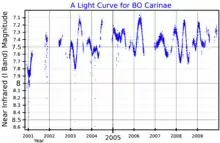 BO Carinae is the brightest red star, towards upper left, in this image of the Carina Nebula. Credit: ESO | |
| Observation data Epoch J2000 Equinox J2000 | |
|---|---|
| Constellation | Carina |
| Right ascension | 10h 46m 00.53s |
| Declination | 59° 29′ 19.5″ |
| Apparent magnitude (V) | 7.18 - 8.50[1] |
| Characteristics | |
| Spectral type | M4 Ib[1] |
| Variable type | Lc[1] |
| Astrometry | |
| Proper motion (μ) | RA: −7.334±0.027[2] mas/yr Dec.: −1.420±0.028[2] mas/yr |
| Parallax (π) | 0.6020 ± 0.0259 mas[2] |
| Distance | 5,400 ± 200 ly (1,660 ± 70 pc) |
| Absolute magnitude (MV) | –5.53[3] |
| Details | |
| Radius | 439[4] R☉ |
| Luminosity | 26,000 - 27,000[4] L☉ |
| Temperature | 3,535±170[4] K |
| Other designations | |
BO Car, IDS 10419-5858, IRAS 10438-5913, 2MASS J10455065-5929193, AAVSO 1042-58, SAO 238447, CD-58 3547, HD 93420 | |
| Database references | |
| SIMBAD | data |
BO Carinae, also known as HD 93420, is an irregular variable star in the constellation Carina.
BO Car has a maximum apparent magnitude of +7.18. Its distance and membership is uncertain, but its possible membership to the star cluster Trumpler 15 allows a distance estimate of approximately 2,500 parsecs (8,150 light-years).[5][6] The Gaia Data Release 2 parallax of 0.73±0.08 mas suggests a closer distance, but the value is considered unreliable due to excess astrometric noise.[7]
BO Car is a red supergiant of spectral type M4Ib with an effective temperature of 3,525 K, a radius of 439 solar radii. Its bolometric luminosity is 26,000 L☉.[3] Mass-loss is on the order of 0.3×10−9 solar masses per year.[6]

Billed as an irregular variable like TZ Cassiopeiae or V528 Carinae; its apparent brightness fluctuates between magnitude +7.18 and +8.50 without clear periodicity.[1][9] Some observers have found BO Car not to be variable,[10] but more extensive studies find small amplitude variations with a possible period of 145 days.[11]
Multiple star catalogues list an 11th-magnitude star as a companion to BO Car. The separation was 14.2″ in 2015, and slowly increasing.[12] The companion is a distant blue giant.[13]
See also
References
- 1 2 3 4 Samus, N. N.; Durlevich, O. V.; et al. (2009). "VizieR Online Data Catalog: General Catalogue of Variable Stars (Samus+ 2007-2013)". VizieR On-line Data Catalog: B/GCVS. Originally Published in: 2009yCat....102025S. 1. Bibcode:2009yCat....102025S.
- 1 2 3 Brown, A. G. A.; et al. (Gaia collaboration) (2021). "Gaia Early Data Release 3: Summary of the contents and survey properties". Astronomy & Astrophysics. 649: A1. arXiv:2012.01533. Bibcode:2021A&A...649A...1G. doi:10.1051/0004-6361/202039657. S2CID 227254300. (Erratum: doi:10.1051/0004-6361/202039657e). Gaia EDR3 record for this source at VizieR.
- 1 2 Levesque, Emily M.; Massey, Philip; Olsen, K. A. G.; Plez, Bertrand; Josselin, Eric; Maeder, Andre; Meynet, Georges (August 2005). "The Effective Temperature Scale of Galactic Red Supergiants: Cool, but Not As Cool As We Thought". The Astrophysical Journal. 628 (2): 973–985. arXiv:astro-ph/0504337. Bibcode:2005ApJ...628..973L. doi:10.1086/430901. S2CID 15109583.
- 1 2 3 Messineo, M.; Brown, A. G. A. (2019). "A Catalog of Known Galactic K-M Stars of Class I Candidate Red Supergiants in Gaia DR2". The Astronomical Journal. 158 (1): 20. arXiv:1905.03744. Bibcode:2019AJ....158...20M. doi:10.3847/1538-3881/ab1cbd. S2CID 148571616.
- ↑ Tapia, Mauricio; Roth, Miguel; Vázquez, Rubén A.; Feinstein, Alejandro (2003). "Imaging study of NGC 3372, the Carina nebula - I. UBVRIJHK photometry of Tr 14, Tr 15, Tr 16 and Car I". Monthly Notices of the Royal Astronomical Society. 339 (1): 44–62. Bibcode:2003MNRAS.339...44T. doi:10.1046/j.1365-8711.2003.06186.x. hdl:11336/36798.
- 1 2 Josselin, E.; Blommaert, J. A. D. L.; Groenewegen, M. A. T.; Omont, A.; Li, F. L. (2000). "Observational investigation of mass loss of M supergiants". Astronomy and Astrophysics. 357: 225–232. Bibcode:2000A&A...357..225J.
- ↑ Brown, A. G. A.; et al. (Gaia collaboration) (August 2018). "Gaia Data Release 2: Summary of the contents and survey properties". Astronomy & Astrophysics. 616. A1. arXiv:1804.09365. Bibcode:2018A&A...616A...1G. doi:10.1051/0004-6361/201833051. Gaia DR2 record for this source at VizieR.
- ↑ "ASAS All Star Catalogue". The All Sky Automated Survey. Retrieved 8 December 2021.
- ↑ Chatys, Filip W.; Bedding, Timothy R.; Murphy, Simon J.; Kiss, László L.; Dobie, Dougal; Grindlay, Jonathan E. (2019). "The period-luminosity relation of red supergiants with Gaia DR2". Monthly Notices of the Royal Astronomical Society. 487 (4): 4832. arXiv:1906.03879. Bibcode:2019MNRAS.487.4832C. doi:10.1093/mnras/stz1584. S2CID 182952598.
- ↑ Percy, John R.; Sato, Hiromitsu (2009-02-01). "Long Secondary Periods in Pulsating Red Supergiant Stars". Journal of the Royal Astronomical Society of Canada. 103 (1): 11. Bibcode:2009JRASC.103...11P. ISSN 0035-872X.
- ↑ Percy, J. R. (2020). "Period Analysis of All-Sky Automated Survey for Supernovae (ASAS-SN) Data on a Sample of "Irregular" Pulsating Red Giants". Journal of the American Association of Variable Star Observers (Jaavso). 48 (1): 50. Bibcode:2020JAVSO..48...50P.
- ↑ Mason, Brian D.; Wycoff, Gary L.; Hartkopf, William I.; Douglass, Geoffrey G.; Worley, Charles E. (2001). "The 2001 US Naval Observatory Double Star CD-ROM. I. The Washington Double Star Catalog". The Astronomical Journal. 122 (6): 3466. Bibcode:2001AJ....122.3466M. doi:10.1086/323920.
- ↑ Brown, A. G. A.; et al. (Gaia collaboration) (August 2018). "Gaia Data Release 2: Summary of the contents and survey properties". Astronomy & Astrophysics. 616. A1. arXiv:1804.09365. Bibcode:2018A&A...616A...1G. doi:10.1051/0004-6361/201833051. Gaia DR2 record for this source at VizieR.